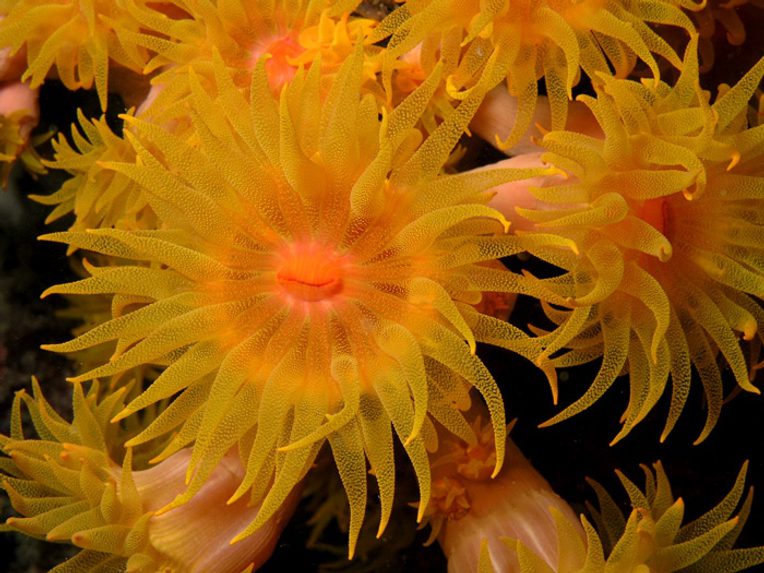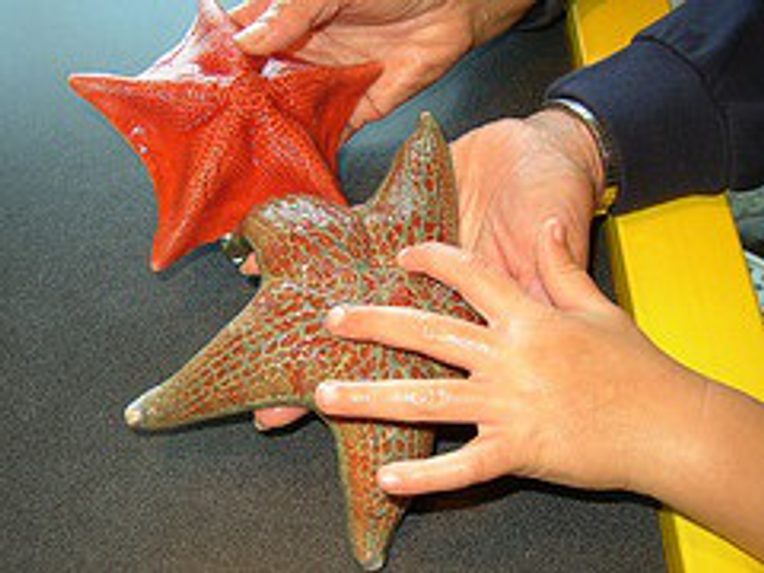This post builds on the research article “Fingeryeyes: Impressions of Cup Corals,” which was published in the November 2010 issue of the Society’s peer-reviewed journal, Cultural Anthropology.

Editorial Footnotes
Cultural Anthropology has published a number of essays on scientific practice. See for example, Deepa Reddy's “Good Gifts for the Common Good: Blood and Bioethics in the Market of Genetic Research" (2007), Michael Montoya's “Bioethnic Conscription: Genes, Race, and Mexicana/o Ethnicity in Diabetes Research” (2007), and Celia Lowe's “Making the Monkey: How the Togean Macaque Went from "New Form" to "Endemic Species' in Indonesians' Conservation Biology” (2004).
Cultural Anthropology has also published essay addressing ontologies of sex/gender, including Tom Boellstorf's “Playing Back the Nation: Waria, Indonesian Transvestites” (2004), Corinne P. Hayden's “Gender, Genetics, and Generation: Reformulating Biology in Lesbian Kinship” (1995), and Esther Newton's “My Best Informant's Dress: The Erotic Equation in Fieldwork” (1993).
Finally, Cultural Anthropology has a few essays on perception and the senses, such as Anna Grimshaw’s “The Bellwether Ewe: Recent Developments in Ethnographic Filmmaking and the Aesthetics of Anthropological Inquiry” (2011) and Peter Benson’s “El Campo: Faciality and Structural Violence in Farm Labor Camps” (2008).

Additional Works by the Author
Hayward, Eva. "Enfolded Vision: Refracting the Love Life of the Octopus." Octopus: A Journal of Visual Studies 1(2005): 29-44.
_______. "More Lessons from a Starfish: Prefixial Flesh and Transpeciated Selves." Womens' Studies Quarterly 36.3-4(2008): 64-85.
_______. "Spider City Sex." Women & Performance 20.3(2010): 225-251.
_______. "When Fish and Frogs Change Gender." Independent Weekly, August 3, 2011. Access article
_______. "Polar Bears, Our Environmental Bellwethers." Independent Weekly, January 4, 2012. Access article
_______. "Schooled by Mackerels: Rachel Carson’s Curiosity." Independent Weekly, April 25, 2012. Access article
Interview with Eva Hayward
Could you discuss how you arrived at this research topic and your haptic-optic methodological approach of "fingeryeyes"? Did either emerge from your training in film studies and feminist/queer theory, or did they develop while in the field?
There are many threads that go into knotting together fingeryeyes: describing an octopus film by Jean Painlevé, talking with my graduate advisor while she wiggles her fingers to demonstrate multiplicity, or the tentacular reaching of tidal pool anemones as they “taste” and pull my fingers toward digestion. So, I would say that fingereyes equally emerged from film studies, feminist science studies, trans/queer theory, and the “field” of a saltwater table at the Long Marine Laboratory.
You have performed other research projects on the sensual encounters between human and nonhuman species, such as with starfish ("More Lessons from a Starfish: Prefixial Flesh and Transspeciated Selves" and spiders ("Spider City Sex"). Why do you choose the nonhuman species you focus on? Do you find some species better to think with, or rather to sense with, on particular topics than others? Do particular species leave stronger "impressions" on you than others?
“More Lessons from a Starfish” aimed to think through the transsexual imaginary of Antony and the Johnson’s song “Cripple and the Starfish.” Antony’s starfish offered me a place to apprehend the regenerative capacities of starfish bodies with the transitional potential of transwomen. I didn’t intend to speak directly about relationships between transsexuals and starfish, but about resonances and dynamic ontologies. In doing so, I suggested that the cut of sex reassignment surgery—a very specific kind of cut—is partly a regenerative act. Cutting the body is an unleashing of potential, reworking the boundaries of bodies. I wrote it as a counter narrative: not confessional, but written in the first person; not about the inherent natures of transsexuality, but about biomaterial potential of sex changing; and, cutting the body maybe healing the body, but in doing so it is also a more-than-human emergence. “Spider City Sex” is a wayward piece—more about webs than spiders, but with a synechdochic understanding that the web is an auto-bio extension of the spider itself. Focusing on San Francisco’s Tenderloin neighborhood where transwomen come together to play, work and live, I conceived that the spider’s web described the effect place and time has on a transitioning body. Transitioning is webbing: at one level a subject acts, but as with spider silk, equally the vibrating force of the web causes the subject. What these pieces on spiders and starfish share is an attention to openness, resource and reach. So, it isn’t so much that I focused on nonhumans as I find the nonhuman already vibrating through what we call the human. In this way, certain expressive capacities, such as webbing or regenerating, can help us hold open the question of the human (or the transsexual for that matter)—not only what or who am I, but also what enables me to do so?
You argue the power dynamic of laboratory practice is not simply about total control and captivity, but also about the unexpected consequences that arise when species touch and leaves impressions upon one another. Nonetheless, the fact that power remains asymmetrical and knowledge production creates ethical "response-ability" between humans and nonhumans seems to be a crucial issue for you throughout the article. How would you characterize the "response-ability" between the human researchers (including yourself) and the coral, particularly in those moments when human touch contributed to the death of these nonhumans? Did your queer perspective influence the way you thought about this issue, particularly given the entwinement you point to between inverts and perverts, queers and animals? Did other individuals negotiate the balance between knowledge production and ethics in different ways?
This is an excellent question. Many readers of the essay have noted this tension. Some wished I refused an “other”—that Hegelian trap—and stayed tuned to the expressive acts (Deleuzian perhaps) of corals and researchers. I couldn’t entirely, since aesthetically and politically, I am troubled by laboratory experiments on animals, even those that propose a benefit for the health of a species such as coral conservation. Who’s future are we hoping to aid? Which future? And still, I remained committed to understanding power as a distributed force with many effects. Corals are not inconsequential forces. Not wanting to pretend that I could distance myself from the problem, I stayed. “Inverts”—its multiple meanings: invert as invertebrate, invert as trans, or put in the opposite position—was one way to point toward this bind. The desire for recognition—a coral other with whom to identify—and its ultimate failure, otherness doesn’t get us very far from anthropomorphism. Sometimes anthropomorphism is important, but this wasn’t my project. I wanted to emphasize the spatial and prepositional import of invert, to invert relations in order to learn something about the redynamizing force of impressions and sense-ability.
Do you have a book project that will be based on this work? If so, could you discuss the overarching arguments you hope to make? There are two projects here, I think. One, with the starfish and spider materials, explores the re-naturalizing (not to be confused with essentialist projects) force of transsexuality. How is transsexuality an expressive potential? If life is an engine for variation, then how might sexual difference be sexual differences?
Intervening in the hyper-representational discourse of trans*, this project offers trans*materiality as a counter to the many misrepresentations of transsexual becoming. The second project, which includes my discussion of corals, is also a materialist project, but focuses on media and marine animals. Studying proximities, impressions, refractions and immersions, I foreground the way marine organisms become our mediations, instructing us on how not only to visualize species difference, but how species impress us to see. Not just surfaces on which knowledge dwells, these animals are quite literally the lenses, the transparencies, through which we make sense sense-able.
What is the future trajectory of your research?
I wish I knew . . .
Related Readings
Giffney, Noreen and Myra Hird, eds. Queering the Non/Human. Burlington, VT: Ashgate, 2008.
Haraway, Donna. When Species Meet. Minneapolis: University of Minnesota Press, 2008.
Helmreich, Stefan. Alien Ocean: Anthropological Voyages in Microbial Seas. Berkeley: University of California Press, 2009.
_______. "How Like a Reef." 2010. http://reefhelmreich.blogspot.com/2010/11/stefan-helmreich.html
Kohn, Eduardo. "How Dogs Dream: Amazonian Natures and the Politics of Transspecies Engagement." American Ethnologist 34.1(2007): 3-24.
McHugh, Susan. "Queer (and) Animal Theories." GLQ 15.1(2008): 153-169.
Questions for Classroom Discussion
1. What does the author mean by “fingeryeyes”? How is this concept used to analyze encounters between researchers and cup corals in the laboratory, particularly in regard to agency, ontology, and perception?
2. How are the multispecies encounters in this laboratory shaped by power and ethics?
3. How does the author understand and deploy the concept of “species”? How are organisms related to their environment?